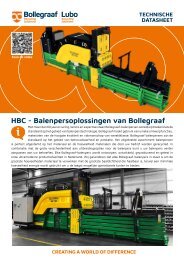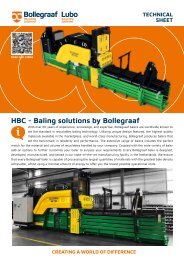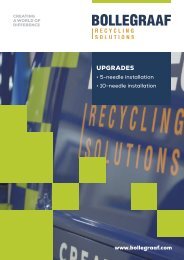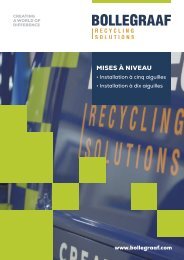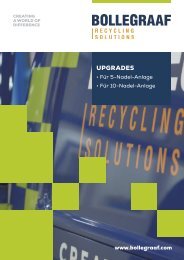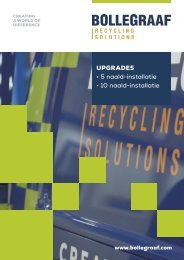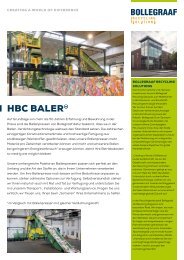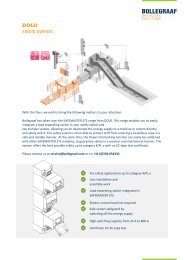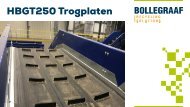Poster balers Bollegraaf
A poster with everything you need to know about the balers from Bollegraaf
A poster with everything you need to know about the balers from Bollegraaf
Create successful ePaper yourself
Turn your PDF publications into a flip-book with our unique Google optimized e-Paper software.
4<br />
6<br />
2<br />
1<br />
3<br />
5<br />
1<br />
High-tech hydraulic unit<br />
∞ Compact system layout<br />
∞ Smooth-running hydraulics<br />
∞ Energy-efficient oil cooling<br />
unit<br />
∞ High-quality cylinders<br />
Unique pre-press flap<br />
∞ Optimizes baling capacity<br />
∞ Saves energy and time<br />
∞ Reduces wear and tear<br />
∞ Lower operational costs<br />
∞ More versatile<br />
2 3 4<br />
5<br />
6<br />
Mainpress<br />
Advanced tying system<br />
∞ Strong proven design, ∞ Single needle system<br />
minimal wear parts<br />
∞ Unique twist finger<br />
∞ Fast-acting<br />
Smart operating system<br />
∞ Full process control<br />
∞ Storage and feedback of<br />
process data<br />
∞ Quick preset menus<br />
∞ Touch screen control<br />
∞ Real-time baler data<br />
Hydraulic power pack<br />
∞ Lowers power consumption<br />
∞ Improves lifespan of oil<br />
∞ Less wear on pumps and<br />
motors<br />
∞ Removes spikes in system<br />
∞ Reduces noise levels<br />
THE ADVANTAGES<br />
∞ Optimized Total Cost of Ownership<br />
∞ Higher bale density<br />
∞ Reduced production time<br />
∞ Low energy usage<br />
∞ High versatility<br />
∞ Easy operation
AVAILABLE OPTIONS: 1 = FEEDING / 2 = MAINTENANCE / 3 = WIRE TYING / 4 = DURABILITY / 5 = EFFICIENCY / 6 = ELECTRICS & CONNECTIVITY / 7 = SAFETY / 8 = STATISTICS & DATA<br />
1A BELT INFEED HOPPER FOR EXTRA WIDE FEED<br />
HOPPER<br />
1B DUST HOOD 1C EXTRA WIDE FEED HOPPER (NO RUFFLER) 1D EXTRA WIDE FEED HOPPER WITH<br />
PERFORATOR (NO RUFFLER)<br />
1E EXTRA WIDE FEED HOPPER WITH RUFFLER<br />
1F EXTRA WIDE FEED HOPPER WITH RUFFLER<br />
AND PERFORATOR<br />
The belt infeed hopper<br />
provides a proper<br />
connection between baler<br />
and feeding conveyor<br />
when the baler is equipped<br />
with a <strong>Bollegraaf</strong> extra<br />
wide feed hopper (EWFH).<br />
The ruffler for the HBC<br />
<strong>balers</strong> was designed to<br />
deal with types of paper<br />
that are difficult to compact<br />
(for instance high<br />
specific weight or very<br />
slippery materials).<br />
A steel driptray is placed<br />
under the hydraulic unit<br />
of the baler. In the case of<br />
leaks, no oil will be spilled<br />
onto the factory floor.<br />
The tray is dimensioned<br />
to theoretically hold the<br />
entire oil volume of the<br />
hydraulic unit.<br />
The electrical cables of the<br />
baler are pulled through a<br />
steel-reinforced hose as a<br />
protection against rodents.<br />
Available for the full baler<br />
or up to a height of 1.5<br />
meters (approx. 59 inches)<br />
above the floor.<br />
1G HYDRAULIC RUFFLER 1H PET BOTTLE PERFORATOR 2A CLEANOUT DOOR FOR BELT INFEED HOPPER<br />
(NO EXTRA PLATFORM)<br />
2E OIL DRIPTRAY 2F OIL IN-DEPTH FILTRATION 2G WIRE-BREAK DETECTION 3A BALER PREPARED FOR PLASTIC WIRES<br />
VERTICAL NEEDLES (PET)<br />
2B AUTO CENTRAL LUBRICATION SYSTEM 2C CLEANOUT CONVEYOR UNDER BALER 2D LIFTING DEVICE KNOTTER<br />
This conveyor is used to<br />
automatically remove<br />
material that accumulates<br />
under the vertical needle<br />
installation. This avoids<br />
the regular necessity of<br />
manually cleaning under<br />
the baler. The removed<br />
material can be collected<br />
easily by for example<br />
placing a container at the<br />
end of the conveyor.<br />
3B CROSS WIRES<br />
4A ANTI-RAT CABLING 4B FULL HARDOX LINING 4C HARDOX BOTTOM FLOOR PLATE ONLY 4D BOLTABLE HARDOX WEAR PLATES 5A ADAPTIVE PROPORTIONAL<br />
CHANNEL PRESSURE SYSTEM (APCP)<br />
5C HYDRAULIC PUMP FREQUENCY CONTROLLED 6A MODEM 6B UNINTERRUPTIBLE POWER SUPPLY<br />
The main hydraulic pump<br />
motor(s) can be equipped<br />
with a frequency inverter.<br />
The use of a frequency<br />
controller has several<br />
(electrical) benefits.<br />
8B BIOS STATISTICS<br />
The dust hood closes off<br />
the feed conveyor and belt<br />
infeed hopper.<br />
This way spillage and dust<br />
coming from the materials<br />
that are being processed<br />
can be limited.The dust<br />
hood is equipped with<br />
an inspection hatch of<br />
600mm*600mm.<br />
The <strong>Bollegraaf</strong> bottle<br />
perforator is a system to<br />
perforate plastic bottles<br />
(PET), prior to the material<br />
entering the press. After<br />
perforation, the material<br />
can be effectively pressed<br />
into bales which are more<br />
homogeneous, compacter<br />
and heavier.<br />
An external filter unit is<br />
installed to remove<br />
contamination (up to 1<br />
micron) from the hydraulic<br />
oil. By means of a<br />
motor-pump unit, which is<br />
integrated in the filter unit,<br />
the oil is pumped from the<br />
tank, filtered, and pumped<br />
back into the tank in a<br />
highly purified condition.<br />
Hardox is a very hardwearing<br />
steel type<br />
especially designed to<br />
be resistant to abrasives.<br />
Hardox plates are advised<br />
when materials are<br />
processed that contain a<br />
high amount of sand, glass<br />
or other abrasives.<br />
A modem makes it possible<br />
for <strong>Bollegraaf</strong> Service<br />
technicians to remotely<br />
connect to the baler’s<br />
PLC through an internet<br />
connection. This can be<br />
useful to help diagnose<br />
problems in the software<br />
or optimizing settings for<br />
specific materials.<br />
8C BIOS ENERGY<br />
In order to deal with the<br />
in-flow of larger pieces of<br />
waste that are carried in<br />
on a wide conveyor belt<br />
(2000 mm), the baler can<br />
be equipped with a wider<br />
feed hopper (filling aperture).<br />
The extra wide feed<br />
hopper is mounted on the<br />
filling opening of the baler.<br />
The cleanout wall is used<br />
to gain access to the belt<br />
infeed hopper in case of<br />
jamming caused by for<br />
example light voluminous<br />
cardboard boxes that get<br />
stuck, after they are fed<br />
into the hopper.<br />
The wire-break detection<br />
option warns whenever<br />
one of the baling wires is<br />
broken or when the wire<br />
is all used up. With wire<br />
brake detection, sensors<br />
are added to the wire guiding<br />
wheels that monitor<br />
the rotation. Available for<br />
both horizontal and<br />
vertical baling wires.<br />
The baler will be equipped<br />
with a Hardox bottom<br />
plate. Thanks to the great<br />
resistance to wear and tear<br />
of Hardox, the lifespan of<br />
the baler’s bottom plate is<br />
lengthened.<br />
The UPS can provide emergency<br />
power to the machine, when the<br />
regular input power source fails.<br />
The run-time of the uninterruptible<br />
power supply is relatively short but<br />
sufficient to properly shut down<br />
and protect the equipment. The<br />
UPS is used to protect hardware<br />
such as the PLC, HMI, and other<br />
sensitive hardware in the switchbox<br />
where an unexpected power<br />
disruption could cause software<br />
problems, hardware failure or data<br />
loss. This option is available for<br />
Siemens PLC’s.<br />
8D BIOS OFFICE<br />
The extra wide feed<br />
hopper can be combined<br />
with a perforator.<br />
The equipment is set up in<br />
such a manner, that only<br />
one of these two devices<br />
is in operation at the same<br />
time.<br />
The automatic lubrication<br />
system uses an<br />
electrically driven grease<br />
pump mounted on the<br />
side of the baler. Multiple<br />
grease distributors ensure<br />
a correct dosage of grease<br />
to the points to be lubricated.<br />
The tying installation for<br />
the vertical wires of the<br />
baler can be set up to tie<br />
up bales with plastic wires.<br />
This can be beneficial for<br />
certain situations where<br />
steel wire would lead to<br />
problems in the processing<br />
of the finished bales.<br />
The <strong>balers</strong> HBK60, HBC130<br />
and HBC150S can be equipped<br />
with boltable Hardox<br />
plates. When worn out,<br />
these plates can be replaced<br />
more easily than traditional<br />
stitch welded plates. Larger<br />
bale chamber doors on both<br />
sides of the machine allow<br />
the plates to be removed<br />
from the inside of the baler.<br />
7A BOSS: BOLLEGRAAF OPERATOR<br />
SAFETY SYSTEM<br />
BOSS puts an<br />
electromagnetic field<br />
around the danger zone<br />
the top section of the feed<br />
conveyor and the opening<br />
of the baler. The size of<br />
this field can be set (1-6<br />
meters) so you can adjust<br />
this zone to suit your<br />
situation.<br />
The extra wide feed<br />
hopper can also be<br />
equipped with a<br />
hydraulically driven ruffler,<br />
whereby the control is<br />
hydraulically integrated<br />
with that of the hopper.<br />
In addition to the standard<br />
5 vertical wires, bales can<br />
also be tied with 3 or 5<br />
horizontal wires. As a<br />
result, a minimum amount<br />
of material drops out of<br />
the bale during handling.<br />
The APCP regulates both pressure<br />
as well as continuously variable oil<br />
supply automatically so that the<br />
baling process will always perform<br />
optimally. The APCP controls the<br />
hydraulic system in such a way<br />
that regardless of the type of<br />
material properties (hard, soft,<br />
smooth, rough, dense or<br />
voluminous), conditions (wet or<br />
dry) and filling method, the bales<br />
are formed as compact as possible.<br />
7B MECHANICAL SAFETY INTERLOCKS<br />
In addition to an electric<br />
safety switch, the access<br />
doors can also be equipped<br />
with a mechanical lock.<br />
Access is obtained with a<br />
key that becomes available<br />
when the main switch of<br />
the switch box is locked.<br />
The extra wide feed<br />
hopper is fitted with both<br />
a perforator as well as a<br />
hydraulic driven ruffler,<br />
the operation of which is<br />
integrated hydraulically<br />
with that of the hopper.<br />
The hydraulic lifting<br />
mechanism of the tying<br />
system ensures easy<br />
maintenance of the tying<br />
system, the needle heads,<br />
and the needle rods.<br />
The lifting mechanism is<br />
avaiable for both the vertical<br />
and horizontal needle<br />
installation.<br />
3C HORIZONTAL WIRES ONLY<br />
The standard configuration<br />
for every baler is a vertical<br />
needle installation. In this<br />
configuration only a<br />
horizontal needle<br />
installation is used.<br />
5B EXTRA CHANNEL CILINDER<br />
To increase the bale weight the<br />
baler can be equipped with an extra<br />
channel cylinder that is fitted in the<br />
middle of the channel to distribute<br />
the counterpressure more effectively<br />
over the bale. Dispersion of force<br />
prevents the channel from twisting<br />
so that the material can be pressed<br />
more smoothly through the channel<br />
and there will be less stress on the<br />
frame. The increase in weight and<br />
density of the bales reduces wires<br />
breaking and requires less tying wire<br />
per ton.<br />
The BIOS SCADA plugin<br />
allows data regarding the<br />
performance of a baler to<br />
be processed in an external<br />
SCADA<br />
(Supervisory Control and<br />
Data Acquisition) system.<br />
8A BIOS SCADA<br />
With BIOS statistics the standard<br />
execution of BIOS will be expanded<br />
with multiple logged data that<br />
supplies the user with extra<br />
insights in the operation of the<br />
baler. The data can be found<br />
through the control panel. The<br />
following statistics can be read<br />
out per day /month for a total of<br />
12 months: Time on press – Total<br />
running time baler / Wire usage<br />
/ Time in automatic / Waiting<br />
time for material / Efficiency in<br />
automatic / Efficiency according to<br />
schedule.<br />
With BIOS Energy the<br />
standard operating system is<br />
expanded with<br />
information on:<br />
- Total energy consumption<br />
for processed material<br />
- Energy consumption<br />
average per bale<br />
To register the consumption,<br />
the switchbox will be supplied<br />
with a KWh-meter.<br />
BIOS Office provides a reporting<br />
functionality. The registration<br />
of the production data is made<br />
available in an Office-environment<br />
over a network. The network<br />
connection from the office to the<br />
switchbox of the baler is not part<br />
of the delivery. Through the<br />
<strong>Bollegraaf</strong> software, a multitude of<br />
data can be read out. BIOS Office<br />
will be installed on a separate PC<br />
and can export all these reports<br />
in metric or imperial units to PDF,<br />
Microsoft Excel, or Word.<br />
CREATING<br />
A WORLD OF<br />
DIFFERENCE<br />
www.bollegraaf.com




